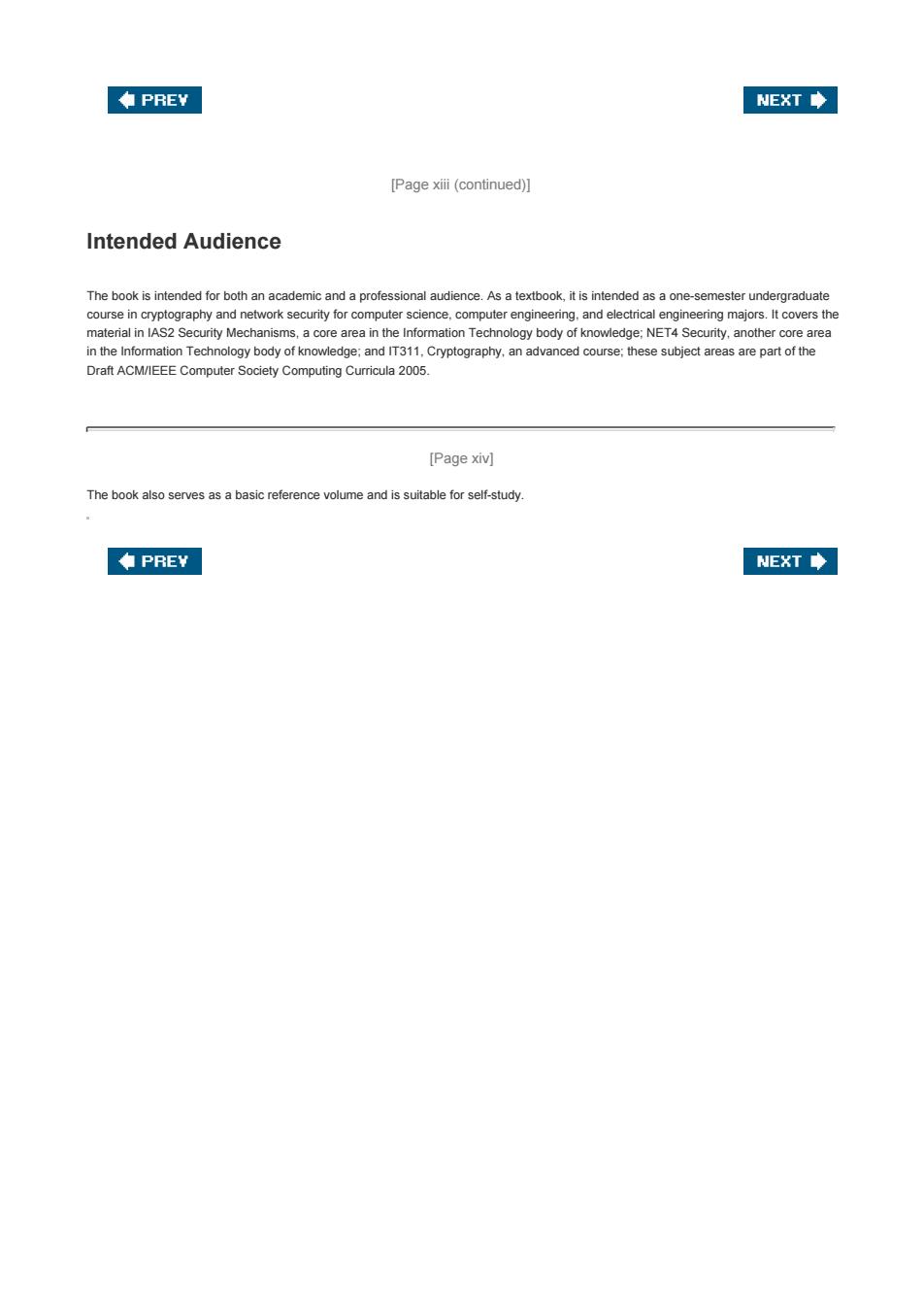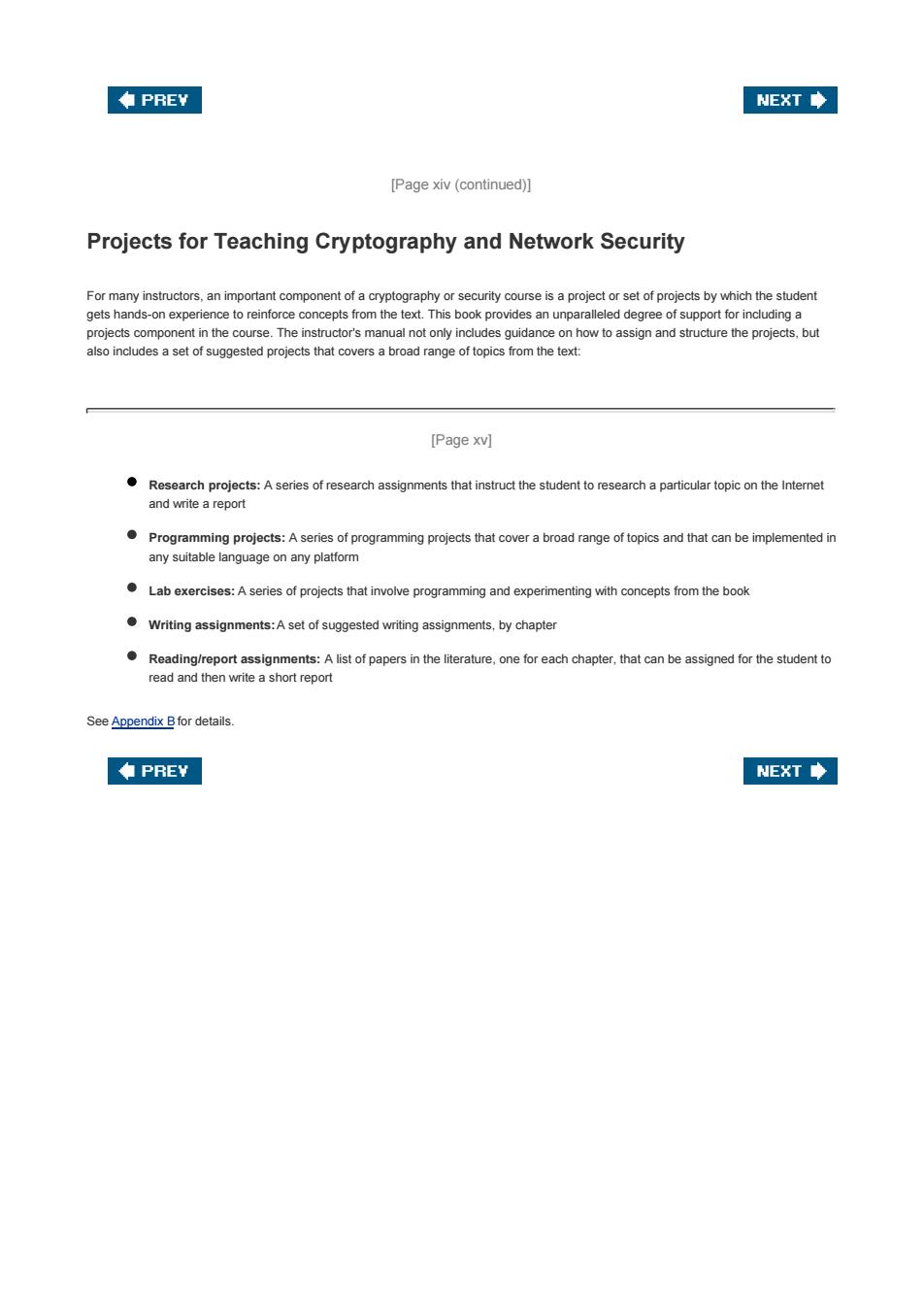
◆PREY NEXT◆ [Page xii(continued)] Intended Audience The book is intended for both an academic and a professional audience.As a textbook,it is intended as a one-semester undergraduate course in cryptography and network security for computer science,computer engineering,and electrical engineering majors.It covers the material in IAS2 Security Mechanisms,a core area in the Information Technology body of knowledge;NET4 Security,another core area in the Information Technology body of knowledge:and IT311.Cryptography,an advanced course:these subject areas are part of the Draft ACM/IEEE Computer Society Computing Curricula 2005. [Page xiv] The book also serves as a basic reference volume and is suitable for self-study. ◆ PREY NEXT◆
[Page xiii (continued)] Intended Audience The book is intended for both an academic and a professional audience. As a textbook, it is intended as a one-semester undergraduate course in cryptography and network security for computer science, computer engineering, and electrical engineering majors. It covers the material in IAS2 Security Mechanisms, a core area in the Information Technology body of knowledge; NET4 Security, another core area in the Information Technology body of knowledge; and IT311, Cryptography, an advanced course; these subject areas are part of the Draft ACM/IEEE Computer Society Computing Curricula 2005. [Page xiv] The book also serves as a basic reference volume and is suitable for self-study

◆PREY NEXT◆ [Page xiv(continued)] Plan of the Book The book is organized in four parts: Part One.Conventional Encryption:A detailed examination of conventional encryption algorithms and design principles,including a discussion of the use of conventional encryption for confidentiality. Part Two.Public-Key Encryption and Hash Functions:A detailed examination of public-key encryption algorithms and design principles.This part also examines the use of message authentication codes and hash functions,as well as digital signatures and public-key certificates. Part Three.Network Security Practice:Covers important network security tools and applications,including Kerberos,X.509v3 certificates,PGP,S/MIME,IP Security,SSL/TLS,and SET. Part Four.System Security:Looks at system-level security issues,including the threat of and countermeasures for intruders and viruses,and the use of firewalls and trusted systems. In addition,the book includes an extensive glossary,a list of frequently used acronyms,and a bibliography.Each chapter includes homework problems,review questions,a list of key words,suggestions for further reading,and recommended Web sites. A more detailed,chapter-by-chapter summary of each part appears at the beginning of that part. ◆PREY NEXT◆
[Page xiv (continued)] Plan of the Book The book is organized in four parts: Part One. Conventional Encryption: A detailed examination of conventional encryption algorithms and design principles, including a discussion of the use of conventional encryption for confidentiality. Part Two. Public-Key Encryption and Hash Functions: A detailed examination of public-key encryption algorithms and design principles. This part also examines the use of message authentication codes and hash functions, as well as digital signatures and public-key certificates. Part Three. Network Security Practice: Covers important network security tools and applications, including Kerberos, X.509v3 certificates, PGP, S/MIME, IP Security, SSL/TLS, and SET. Part Four. System Security: Looks at system-level security issues, including the threat of and countermeasures for intruders and viruses, and the use of firewalls and trusted systems. In addition, the book includes an extensive glossary, a list of frequently used acronyms, and a bibliography. Each chapter includes homework problems, review questions, a list of key words, suggestions for further reading, and recommended Web sites. A more detailed, chapter-by-chapter summary of each part appears at the beginning of that part

◆PREY NEXT◆ Page xiv (continued)] Internet Services for Instructors and Students There is a Web site for this book that provides support for students and instructors.The site includes links to other relevant sites, transparency masters of figures and tables in the book in PDF(Adobe Acrobat)format,and PowerPoint slides.The Web page is at WilliamStallings.com/Crypto/Crypto4e.html.As soon as typos or other errors are discovered,an errata list for this book will be available at WilliamStallings.com.In addition,the Computer Science Student Resource site,at WilliamStallings.com/StudentSupport.html, provides documents,information,and useful links for computer science students and professionals. ◆PREV NEXT◆
[Page xiv (continued)] Internet Services for Instructors and Students There is a Web site for this book that provides support for students and instructors. The site includes links to other relevant sites, transparency masters of figures and tables in the book in PDF (Adobe Acrobat) format, and PowerPoint slides. The Web page is at WilliamStallings.com/Crypto/Crypto4e.html. As soon as typos or other errors are discovered, an errata list for this book will be available at WilliamStallings.com. In addition, the Computer Science Student Resource site, at WilliamStallings.com/StudentSupport.html, provides documents, information, and useful links for computer science students and professionals

◆PREY NEXT◆ [Page xiv (continued)] Projects for Teaching Cryptography and Network Security For many instructors,an important component of a cryptography or security course is a project or set of projects by which the student gets hands-on experience to reinforce concepts from the text.This book provides an unparalleled degree of support for including a projects component in the course.The instructor's manual not only includes guidance on how to assign and structure the projects,but also includes a set of suggested projects that covers a broad range of topics from the text: [Page xv] ● Research projects:A series of research assignments that instruct the student to research a particular topic on the Internet and write a report Programming projects:A series of programming projects that cover a broad range of topics and that can be implemented in any suitable language on any platform Lab exercises:A series of projects that involve programming and experimenting with concepts from the book Writing assignments:A set of suggested writing assignments,by chapter Reading/report assignments:A list of papers in the literature,one for each chapter,that can be assigned for the student to read and then write a short report See Appendix B for details. ◆PREV NEXT◆
[Page xiv (continued)] Projects for Teaching Cryptography and Network Security For many instructors, an important component of a cryptography or security course is a project or set of projects by which the student gets hands-on experience to reinforce concepts from the text. This book provides an unparalleled degree of support for including a projects component in the course. The instructor's manual not only includes guidance on how to assign and structure the projects, but also includes a set of suggested projects that covers a broad range of topics from the text: [Page xv] Research projects: A series of research assignments that instruct the student to research a particular topic on the Internet and write a report Programming projects: A series of programming projects that cover a broad range of topics and that can be implemented in any suitable language on any platform Lab exercises: A series of projects that involve programming and experimenting with concepts from the book Writing assignments: A set of suggested writing assignments, by chapter Reading/report assignments: A list of papers in the literature, one for each chapter, that can be assigned for the student to read and then write a short report See Appendix B for details

◆PREY NEXT◆ [Page xv(continued)] What's New in the Fourth Edition In the three years since the third edition of this book was published,the field has seen continued innovations and improvements.In this new edition,I try to capture these changes while maintaining a broad and comprehensive coverage of the entire field.To begin this process of revision,the third edition was extensively reviewed by a number of professors who teach the subject.In addition,a number of professionals working in the field reviewed individual chapters.The result is that,in many places,the narrative has been clarified and tightened,and illustrations have been improved.Also,a large number of new"field-tested"problems have been added. Beyond these refinements to improve pedagogy and user friendliness,there have been major substantive changes throughout the book. Highlights include the following: Simplified AES:This is an educational,simplified version of AES(Advanced Encryption Standard).which enables students to grasp the essentials of AES more easily. Whirlpool:This is an important new secure hash algorithm based on the use of a symmetric block cipher. CMAC:This is a new block cipher mode of operation.CMAC(cipher-based message authentication code)provides message authentication based on the use of a symmetric block cipher Public-key infrastructure(PKI):This important topic is treated in this new edition. Distributed denial of service(DDoS)attacks:DDoS attacks have assumed increasing significance in recent years. Common Criteria for Information Technology Security Evaluation:The Common Criteria have become the intemational framework for expressing security requirements and evaluating products and implementations. Online appendices:Six appendices available at this book's Web site supplement the material in the text. In addition,much of the other material in the book has been updated and revised. ◆PREY NEXT◆
[Page xv (continued)] What's New in the Fourth Edition In the three years since the third edition of this book was published, the field has seen continued innovations and improvements. In this new edition, I try to capture these changes while maintaining a broad and comprehensive coverage of the entire field. To begin this process of revision, the third edition was extensively reviewed by a number of professors who teach the subject. In addition, a number of professionals working in the field reviewed individual chapters. The result is that, in many places, the narrative has been clarified and tightened, and illustrations have been improved. Also, a large number of new "field-tested" problems have been added. Beyond these refinements to improve pedagogy and user friendliness, there have been major substantive changes throughout the book. Highlights include the following: Simplified AES: This is an educational, simplified version of AES (Advanced Encryption Standard), which enables students to grasp the essentials of AES more easily. Whirlpool: This is an important new secure hash algorithm based on the use of a symmetric block cipher. CMAC: This is a new block cipher mode of operation. CMAC (cipher-based message authentication code) provides message authentication based on the use of a symmetric block cipher. Public-key infrastructure (PKI): This important topic is treated in this new edition. Distributed denial of service (DDoS) attacks: DDoS attacks have assumed increasing significance in recent years. Common Criteria for Information Technology Security Evaluation: The Common Criteria have become the international framework for expressing security requirements and evaluating products and implementations. Online appendices: Six appendices available at this book's Web site supplement the material in the text. In addition, much of the other material in the book has been updated and revised